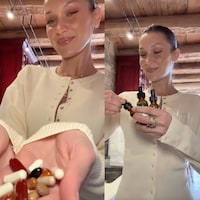Forgoing gruelling workouts, people are drawing on abs with make-up and fake tan – we explore the process and its potentially damaging implications
In her acceptance speech at the Screen Actors Guild Awards earlier this year, Fleabag creator Phoebe Waller-Bridge broke the fourth wall of celebrity artifice by referencing the six pack her make-up artist had drawn on earlier that night. The revelation was evidence enough that as a culture, we are thoroughly obsessed with abs. That’s not necessarily a new thing. While the media has become more open-minded to diverse representations of the human body in recent years, slim remains the norm on red carpets and magazine covers. What’s more, celebrities like Gigi Hadid, Teyana Taylor, and Emily Ratajkowski have raised the bar from merely skinny to extreme-looking, highly defined stomachs.
Pronounced abdominal muscles, sometimes collectively referred to as a six pack, have been fashionable for centuries. Walk the halls of any hallowed museum, and you’ll find statues of men, like the famous David, chiselled beyond imagination. Part athletes part deities, the honed Ancient Greek figure would rival any Brad Pitt physique of today. Compared to Mark Wahlberg’s 1992 Calvin Klein ad, and the sculpted frames of Idris Elba, Zac Efron, Usher, Hugh Jackman and the entire cast of Magic Mike, little has changed when it comes to the ideal male body. Although, on the flip side, Leonardo DiCaprio’s open defiance of these ideals in his downtime and the rise of the ‘dad bod’ act as a resistance.
What has changed, though, is the way society values visible musculature on women’s bodies. The hourglass-figured, soft-bellied pin-ups of Marilyn Monroe’s ilk made way for Cher’s washboard abs, imprinted in the collective memory when the singer-actress flaunted them at the 1973 Oscars. In the following decades, stars like Janet Jackson, Halle Berry, and Jennifer Lopez took the baton and assumed the position of best six packs in Hollywood.
The rise of athleisure and core-strengthening workouts have brought women’s abs into the spotlight beyond the beach. As fitness and wellness culture grow increasingly intertwined, the pursuit of a washboard waist feels more relevant than ever. There are several ways to achieve the perfect sculpted six pack. Gruelling daily exercise coupled with a strict diet and a bit of patience might get you to washboard status in weeks or months. But you’ll need to stick with the routine as long as you want to maintain the effect. Plastic surgery techniques like abdominal etching and the aptly-named Adonis procedure can get you there in less time if you’re willing to shell out the hefty price tag.
For the less committed (with less disposable income), temporary contouring with make-up and/or fake tan can be a relatively quick way to tone up for a photoshoot or special event. “The midriff area has become the hottest part of the body to have peek out of your clothes,” says Kristyn Pradas, a Los Angeles-based airbrush tanning artist who says ab contouring is the number one request she gets from clients. “Everyone loves a good body contour. It can boost your confidence when wearing an outfit or even just in the privacy of your own home.”
“The painted-on abs trend is more about enhancing the muscle definition you already have rather than creating a six pack from scratch. In this sense, it’s not necessarily the product of unhealthy societal ideals, but rather an adjunct to the restrictive diets and gruelling training we already put ourselves through in pursuit of the ‘ideal’ body”
Although it has never fully caught on in the consumer market, body make-up is standard practice among professional make-up artists. “Any good make-up artist knows that make-up doesn’t stop on the face,” says Jonny Polizzi, a Manhattan-based make-up artist and owner of The Center of Makeup Artistry and Design. But Polizzi also warns that while this make-up may look great on film, it doesn’t translate well in the flesh, where lighting is unpredictable and unforgiving.
The basic concept of contouring is painting on shadows to strategically trick the eye into perceiving depth. “Just follow the lines of the muscles and whatever you make darker, that’s going to push it back. Whatever you make lighter is going to appear more forward in the image,” says Australian-born, New York-based make-up artist Tobi Henney. To get the effect, she recommends using a cream product (like Tom Ford Shade and Illuminate) and setting it with a powder. A similar effect can be created using fake tan, says Pradas, who has her clients flex certain muscles to help her accentuate accordingly.
Given the rise of heavily contoured faces, it’s a natural progression for the body to receive the same treatment. Body contouring first came into the mainstream in 2016, when Australian vlogger Chloe Morello shared a tongue-in-cheek tutorial poking fun at what was then the height of contour mania. The satirical how-to video introduced those not in the know to the seemingly outrageous manifestation of a trend-gone-too-far. In actuality, using make-up to shade indents and enhance the look of peaks and valleys below the face is fairly common. From the cleavage and clavicles of stars like Mandy Moore and Kristen Bell, to full body foundation on Beyoncé.
Part of the appeal of Netflix’s docuseries Cheer is how it lays bare the drastic physical and aesthetic demands in the Navarro College cheer team’s quest for even more championship glory unflinchingly. The constant pursuit for bodily perfection can lead to an atmosphere of inadequacy, something Chelsey, a former high school cheerleader who first used make-up to contour her abdomen as a freshman, knows only too well. "My coach said that we needed to have our abs pop while we were on stage and that he wanted the judges to be able to see our abs in our uniform. Wow, this sounds so fucked saying it out loud.” Already insecure about her abs before her coach introduced contouring (a ritual which remains popular among cheerleaders today), her squadmates cleverly applied six packs on each other. “Doing that made me super self-conscious in my overall life, like why am I drawing on my abs? I should look like this all the time and then I wouldn’t have to do this.”
Given what seems to be a cooldown of the facial contouring craze, how popular is body contouring now? It’s alive and well in the fitness arena. “Every guy I’ve ever worked with is like, ‘Hey, can you make my abs look more defined?’” says Polizzi. Muscle-emphasising contour make-up also plays a big role in bodybuilding competitions and Broadway productions, where exaggerated visuals help play to crowds in the nosebleed seats. Polizzi, who has worked on Broadway shows in the past, says, “If they don’t have shirts on then we are 150 per cent contouring them to the 10th degree.”
The way Polizzi sees it, contouring has become a confidence booster, assuming the role of an on-set security blanket. For buff male models, that’s in the form of a little extra shading to enhance the muscles they already have. “Sometimes I will take just a brush with no make-up on it and pretend so that the client feels better.” He finds this especially useful on shoots where having a model look super chiselled and hyper muscular would feel incongruous.
Ultimately contouring is an optical illusion best suited for the digital world. On Instagram, film, or television, with just enough distance and otherworldliness to seem real. The effect creates a sort of Cinderella-like perfection – abs for a day, but you turn back into a pumpkin when your six pack washes down the drain at the end of the night. But the revelation of Phoebe Waller-Bridge’s painted-on abs may well be a fluke rather than a peephole into the vault of top-secret celebrity intel. If her candour seemed like the first clue to a mysterious scavenger hunt that ends with J.Lo, Marky Mark, and The Rock washing off their body contour to reveal normal-looking people with average bodies and natural folds, then perhaps it was a false alarm.
Are six packs just the newest blip in a long line of impossible and oppressive body ideals? Yes and no. The painted-on abs trend is more about enhancing the muscle definition you already have rather than creating a six pack from scratch. In this sense, it’s not necessarily the product of unhealthy societal ideals, but rather an adjunct to the restrictive diets and gruelling training we already put ourselves through in pursuit of the “ideal” body. On the one hand, the proliferation of ab make-up propels perfection while obscuring and enhancing reality. On the flip side, popular culture hasn’t always rewarded women for being strong, in any sense of the word. Like most cosmetic trends, six pack contouring may be a double-edged sword.




